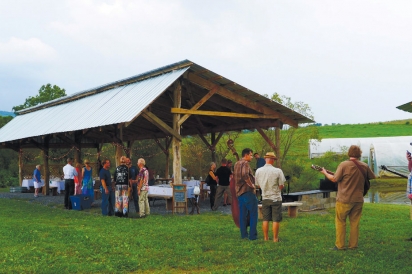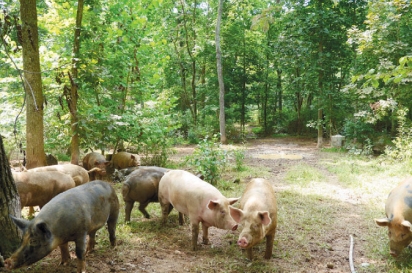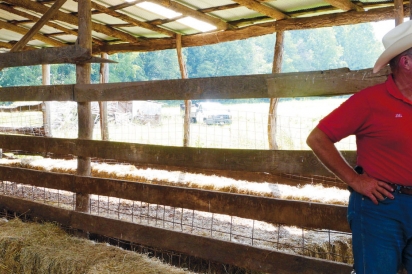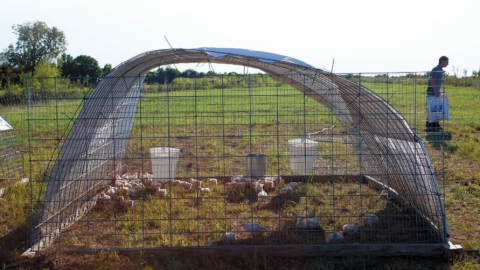Face to Face at Polyface
A first-hand look at Joel Salatin’s back-to-the-future farm
The bright, cold air of the Shenandoah Valley welcomes us as we step out of the car at Polyface Farm (“farm of many faces”). All around me, as far as the eye can see, are the purple-tipped Blue Ridge mountains, dotted at their bases with flourishes of green and wildflowers. The whole scene might be out of a Wendell Berry daydream.
We’ve traveled to Virginia for a weekend with the agrarian-contrarian legend himself, Joel Salatin. Tonight’s affair is a special dinner for those who have come down for the weekend’s conference early for an intimate farm dinner. “A premium night at Polyface Farm” comes at a hefty price tag, but all funds raised go to support the Farm to Consumer Legal Defense Fund, an organization founded to help provide legal aid to farmers. Tomorrow will bring a tour of the farm; Sunday, a holistic health conference. But for tonight, it’s all about indulging Joel Salatin and his bounty.
As we wait for the dinner to commence, the interns and residents of the multi-generational family farm buzz around us, preparing the various moving parts of the evening: mix-and-match dishes, place settings at the long wooden farm table, citronella candles to discourage thirsty Virginia mosquitoes, sweet tea. Throughout all of it, the simplistic routine of farm life is written on the faces of its inhabitants like a poem 60 years in the making, each generation contributing a verse, ushering in a new stanza. As the weekend unfolds, I’ll come to learn that this is no accident, and that at its core Polyface is about continuity—about building something to last, and getting deep down into the dirt and decay of the soil and tilling it, every day, without fail, to make sure it does.
There’s a new crop of young people flocking to farming. Why? Salatin credits the rise of the “regeneration age.” As he puts it, there’s an entire generation of interested, idealistic young people who want to work and care for the land. These upstarts are finally fed up with the “desperation of the Dilbert cube,” and yearning for something more connective to sink their hands into—a return to the sort of healing work that is both righteous and sacred.
I can see why. Salatin’s words are intelligent and imaginative. He takes the centuries-old concept of farming, and paints it into imagination with carefully chosen eloquence.
“So our mandate is to come not as a wrestling conquistador to wrestle from the earth our sustenance,” he says. “The earth is not a reluctant partner to be coerced. The earth is a benevolent lover to be caressed.”
***
As the sun begins to lie down for the night, dinner commences. We sip mint- and lavender-infused tea, nibble chicken liver pâté from a bird that was dressed the Wednesday before, and munch on plates of pickled vegetables: corn and cauliflower and tomatoes, fat and juicy, crisp to the bite. They are so good, and as the juice runs down my chin, I wipe it away with the back of my hand without so much as a wayward glance at who might’ve seen. I am just happy to taste the earth.
Then come the mains: Polyface’s signature “pigerator” pork tenderloin, which comes stuffed full of spinach, feta and caramelized onions on a bed of homemade cheese grits, and pastured chicken with gravy and collard greens. Dessert is smoky peaches, homemade pie and cobbler with raw-milk cream. Everything tastes like we are on a farm: fresh, simple, rich, unapologetically fatty and rib sticking.
As the lush, verdant slopes of green surrounding us start to blend into the night, as the sprawl of the land changes colors and the blue-brushed mountain hilltops smear like fog in the distance, a quiet starts to cover our dinner party. We chat, sip coffee, talk shop. I have miraculously stumbled onto the great fortune of sitting next to Joel Salatin for dinner, and I lean in to listen to him speak, scribbling notes of anecdotes and policy and parables.
I’m traveling with Angela Faughtenberry, owner of 413 Farm, who is a farmer from Tulsa, Oklahoma— who listens with unwavering focus to the words of her far-away mentor: the Joel Salatin. It becomes clear to me that so many of the people here are like her: pupils, fans, comrades—all eager to soak up every last drop of his ideas. It’s an interesting, humbling experience to watch someone else meet their hero.
Joel Salatin has been called “America’s Most Famous Farmer” by TIME magazine, “Virginia’s most multi-faceted agrarian since Thomas Jefferson,” by the New York Times, and is widely considered to be a pioneer of the “pastured poultry” model of farming, and a major proponent of Management Intensive Rotational Grazing (MIRG).
For those unfamiliar with MIRG, animals are moved daily. The result provides fresh pasture, better animal and soil health and maximized forage growth. It also guarantees a strong vegetative ground cover at all times.
He’s written more than 10 books on ecologically sound and restorative farming practices, and has been working his family farm since 1961. He’s a self-proclaimed “Christian libertarian environmentalist capitalist lunatic farmer.” He is a tireless proponent of the local food movement and of sustainable farm systems.
With Polyface, the Salatins have designed a system that combines manual labor, timeliness, soil regeneration, a natural water supply and the natural ecosystem and instincts of the animals to create a land life cycle that works together in concert to restore itself.
Cows graze ahead of the chickens. The chickens follow the cows three days later, providing pasture sanitation. The pigs are rotated through the forested areas of the farm. They are allowed to express their pigness by aerating the soil. Tilling up the under bush with their snout, creating a park like canopy. It’s cyclical, and it works beautifully. By all accounts, he is an ecological magician.
Though in truth, Salatin calls for a return to roots—something that by its very nature seems radical at a time when everyone is so quick to grab the packaged, processed and injected and call it bounty.
“There’s this belief that our side hates technology,” he explains on the farm tour. “That we’re Luddite Neanderthals.
“But we aren’t going back… we are the new technology that embraces a heritage model. We started with the agrarian economy, then we had the industrial economy, then the information economy. I call this the regenerative economy.”
Indeed, Salatin’s inventiveness suggests quite the opposite of “normal.” Electric fences maintain a perimeter, and animal instinct picks up where fencing leaves off. Gravity-fed pumps transport water to the necessary areas of the pasture, and daily relocation allows for waste (biofuel, manure, carbon, etc.) to be absorbed into the soil more quickly, instead of evaporating. By sticking to a focused, routine schedule, the animals begin to learn and anticipate when the migration will begin, and will even wait expectantly as a herd at the gate every day at 4pm, ready to explore their new frontier. Overall, Salatin’s model is more hygienic, more sanitary and more ethical.
I’m inspired by his work. He has a self-assured confidence that could only come with experience: in the practice, and in the mission set before him by his creator to be a steward of this plot of land for the future generations.
“I like sunbeams,” he says, describing the way the grass takes in energy from the sun to grow. “That’s the stuff of poetry. It’s amazing that this plant can reach up and grab something as mystical and esoteric as sunbeams.”
He’s right: We must be more responsible stewards of our planet. If not, he’s quick to point out, she’ll fight back.









